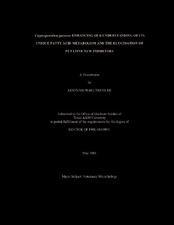| dc.description.abstract | Cryptosporidium parvum is widely known for outbreaks within the immunocompetent population, as well its sometimes excruciating effects as an opportunistic agent in AIDS patients. Our understanding of the biology and host-parasite interactions of this parasitic protist is increasing at a rapid rate due to recent molecular and genetic advances. The topic of our research is in the area of C. parvum fatty acid metabolism, which is highly streamlined in this parasite. In addition to a type I fatty acid synthase (CpFAS1), C. parvum also possesses an enormous type I polyketide synthase (CpPKS1). Because of the size of this megasynthase, functional characterization of the complete enzyme is not possible. We have isolated and characterized the loading unit of CpPKS1 which contains an acyl-[acyl carrier protein (ACP)] ligase (AL) and an ACP. This unit is responsible for the overall substrate selection and initiation of polyketide production. Our data show that CpPKS1 prefers long-chain fatty acids with the highest specificity for arachidic acid (C20). Thus, the final polyketide product could contain as many as 34 carbons. Additionally, C. parvum possesses only a single fatty acid elongase. This family of enzymes serves a mechanism similar to FAS, and many have been found to be involved in de novo fatty acid synthesis in other organisms. After expressing this membrane protein in human cells, we have determined that it too prefers long-chain fatty acyl-CoAs which undergo only one round of elongation. This is in contrast to members of this enzyme family in other organisms that can initiate de novo synthesis from two- or four-carbon fatty acids via several rounds of elongation. Our lab has previously characterized the unique acyl-CoA binding protein (CpACBP1) from C. parvum. Molecular and biochemical data suggested that this enzyme may serve as a viable drug target. We have screened a library of known (and somewhat common) compounds against CpACBP1, and have isolated several potential compounds to be further examined for their ability to inhibit the growth of C. parvum. | en |


